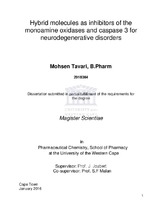| dc.description.abstract | Neurodegenerative diseases are multifactorial in nature, and taking the complex nature of these disorders into consideration, multi-target directed ligands may present as better options to treat these disorders than the classic ‘one molecule, one target’ approach. Neurotransmitter amines are catabolized by monoamine oxidase A and B (MAO-A and MAO-B), therefore they have been targeted for the treatment of neuropsychiatric and neurodegenerative diseases. Besides offering a potential antidepressant action in PD, MAO-A inhibitors may also provide a symptomatic benefit by reducing MAO-A-catalysed oxidation of dopamine. The oxidative deamination reaction catalyzed by MAO-B is one of the major catabolic pathways of dopamine in the brain. Inhibition of this enzyme leads to enhanced dopaminergic neurotransmission and are currently used in the symptomatic treatment of PD. Furthermore, MAO-B inhibitors may also exert neuroprotective effects by reducing the concentration of potentially hazardous by-products produced by MAO-B-catalysed dopamine oxidation. Apoptosis or programmed cell death occurs in a number of neurodegenerative disorders and it has been proven that inhibition of the executing enzyme, caspases-3, slows down or even stops apoptosis. Having this in mind we focused on the propargylamine function of selegiline and the fluorophenyl function of safinamide, because of their inherent monoamine oxidase inhibitory activities; and isatin as a non-peptide inhibitor of caspase-3. Therefore we attempted to design and synthesize multifunctional hybrid molecules acting simultaneously to halt the apoptotic neuronal breakdown process and eliminate the signs and symptoms of diseases such as PD. Seven novel compounds were successfully synthesized utilizing multistep processes. The synthesis of 5 chlorosulfonyl isatin was accomplished starting from the commercially available isatin in two steps, which were, sulfonation using tetramethylene sulfone and chlorination with POCl₃. Next 5-chlorosulfonyl isatin was conjugated to the fluorophenylamine derivative with the fluoro-function at either the ortho, meta or para position through a nucleophilic substitution reaction on the chlorosulfonyl position. The resultant compounds were coupled on the N position of the isatin function with propargyl bromide, using a microwave synthesis procedure, in a nucleophilic substitution reaction. The structures and purity were confirmed by nuclear magnetic resonance (NMR) and mass spectrometry (MS). In the biological evaluations recombinant human MAO-A, MAO-B and caspase 3 enzymatic assays were performed to determine the activity of the novel compounds at an enzymatic level. The inhibition percentages for these compounds were calculated and plotted against the logarithm 8 of the inhibitor concentrations to obtain a sigmoidal dose-response curve and consequently the IC50 value. The synthesized compounds showed inhibition of the MAO-A, MAO-B and caspase-3 enzymes at low to high micro molar concentrations. The role of the fluorophenylamine moiety in the synthesized compounds was significant for their multifunctional activity as shown by compounds 3 and 4 having good inhibitory activity towards MAO-A, MAO-B and also excellent inhibitory activity against caspase 3, making those ideal candidates for further lead compound development and multifunctional drug design. The introduction of the propargylamine moiety only increased the MAO-A inhibitory activity; this was shown by compounds 7, 8 and 9 which exhibit good MAO-A selectivity with low MAO-B and caspase-3 inhibitory activities. | en_US |

